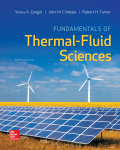
a)
The average temperature of the room after 30 min.
a)
Explanation of Solution
Given:
The dimension of room
The temperature of the room
The volume of the radiator is 15 L.
The pressure of the super-heated vapor
The temperature of the superheated vapor
The pressure of the steam
The time duration
The pressure of the room
Calculation:
Refer the Table A-6, “Superheated water table”, obtain the following properties of steam at temperature of
Refer the Table A-6, “Saturated water-Pressure table”, obtain the following properties of steam at pressure of
Here, Saturated liquid specific volume is
Calculate the final vapor quality.
Refer the Table A-6, “Saturated water-Pressure table”, obtain the following properties of steam at pressure of
Calculate the final internal energy of the system.
Refer the Table A-6, “Saturated water-Pressure table”, obtain the following properties of steam at pressure of
Calculate the final entropy of the system.
Calculate the mass of the steam.
Write the expression for the energy balance equation for closed system without air in the room.
Here, energy transfer into the control volume is
Substitute
Refer the Table A-1, “the molar mass, gas constant and critical point properties table”, select the gas constant of air as
Calculate the mass of the air using the ideal gas equation.
Write the expression to calculate the total work done by the fan.
Refer the Table A-2, “the ideal–gas equation specific heats of various common gases table”, select the specific heat at constant pressure for air as
Substitute
Thus, the average temperature of the room after 30 min is
b)
The entropy change of the steam.
b)
Explanation of Solution
Write the expression to calculate the change of entropy of the steam.
Thus, the entropy change of the steam is
c)
The entropy change of the air.
c)
Explanation of Solution
Write the expression to calculate the entropy change of air.
Since,
Thus, the entropy change of the air is
d)
The entropy generation in the turbine.
d)
Explanation of Solution
Write the expression for the entropy balance equation of the system.
Here, rate of net entropy in is
Substitute
Thus, the total entropy generated during the process is
Want to see more full solutions like this?
Chapter 8 Solutions
EBK FUNDAMENTALS OF THERMAL-FLUID SCIEN
- reaction at a is 1.6 wL (pos) handwritten solutions only please. correct answers upvotedarrow_forward1 8 4 Add numbers so that the sum of any row or column equals .30 Use only these numbers: .1.2.3.4.5.6.10.11.12.12.13.14.14arrow_forwardUppgift 2 (9p) I77777 20 kN 10 kN/m 4 [m] 2 2 Bestäm tvärkrafts- och momentdiagram för balken i figuren ovan. Extrempunkter ska anges med både läge och värde i diagrammen.arrow_forward
- **Problem 8-45.** The man has a mass of 60 kg and the crate has a mass of 100 kg. If the coefficient of static friction between his shoes and the ground is \( \mu_s = 0.4 \) and between the crate and the ground is \( \mu_c = 0.3 \), determine if the man is able to move the crate using the rope-and-pulley system shown. **Diagram Explanation:** The diagram illustrates a scenario where a man is attempting to pull a crate using a rope-and-pulley system. The setup is as follows: - **Crate (C):** Positioned on the ground with a rope attached. - **Rope:** Connects the crate to a pulley system and extends to the man. - **Pulley on Tree:** The rope runs over a pulley mounted on a tree which redirects the rope. - **Angles:** - The rope between the crate and tree forms a \(30^\circ\) angle with the horizontal. - The rope between the tree and the man makes a \(45^\circ\) angle with the horizontal. - **Man (A):** Pulling on the rope with the intention of moving the crate. This arrangement tests the…arrow_forwardplease solve this problems follow what the question are asking to do please show me step by steparrow_forwardplease first write the line action find the forces and them solve the problem step by steparrow_forward
- please solve this problem what the problem are asking to solve please explain step by step and give me the correct answerarrow_forwardplease help me to solve this problem step by steparrow_forwardplease help me to solve this problem and determine the stress for each point i like to be explained step by step with the correct answerarrow_forward
- please solve this problem for me the best way that you can explained to solve please show me the step how to solvearrow_forwardplese solbe this problem and give the correct answer solve step by step find the forces and line actionarrow_forwardplease help me to solve this problems first write the line of action and them find the forces {fx=0: fy=0: mz=0: and them draw the shear and bending moment diagram. please explain step by steparrow_forward
 Elements Of ElectromagneticsMechanical EngineeringISBN:9780190698614Author:Sadiku, Matthew N. O.Publisher:Oxford University Press
Elements Of ElectromagneticsMechanical EngineeringISBN:9780190698614Author:Sadiku, Matthew N. O.Publisher:Oxford University Press Mechanics of Materials (10th Edition)Mechanical EngineeringISBN:9780134319650Author:Russell C. HibbelerPublisher:PEARSON
Mechanics of Materials (10th Edition)Mechanical EngineeringISBN:9780134319650Author:Russell C. HibbelerPublisher:PEARSON Thermodynamics: An Engineering ApproachMechanical EngineeringISBN:9781259822674Author:Yunus A. Cengel Dr., Michael A. BolesPublisher:McGraw-Hill Education
Thermodynamics: An Engineering ApproachMechanical EngineeringISBN:9781259822674Author:Yunus A. Cengel Dr., Michael A. BolesPublisher:McGraw-Hill Education Control Systems EngineeringMechanical EngineeringISBN:9781118170519Author:Norman S. NisePublisher:WILEY
Control Systems EngineeringMechanical EngineeringISBN:9781118170519Author:Norman S. NisePublisher:WILEY Mechanics of Materials (MindTap Course List)Mechanical EngineeringISBN:9781337093347Author:Barry J. Goodno, James M. GerePublisher:Cengage Learning
Mechanics of Materials (MindTap Course List)Mechanical EngineeringISBN:9781337093347Author:Barry J. Goodno, James M. GerePublisher:Cengage Learning Engineering Mechanics: StaticsMechanical EngineeringISBN:9781118807330Author:James L. Meriam, L. G. Kraige, J. N. BoltonPublisher:WILEY
Engineering Mechanics: StaticsMechanical EngineeringISBN:9781118807330Author:James L. Meriam, L. G. Kraige, J. N. BoltonPublisher:WILEY





